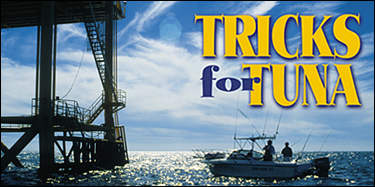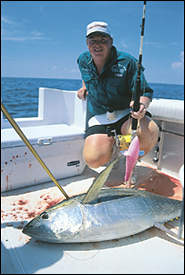|
|

|
 |
 | ||
|
For anglers seeking to fish offshore this fall and winter, party and other larger charter boats might just be the best and safest bet. While tuna may move in closer to shore in the winter than during the warmer months, they're still generally farther out than most individuals should venture in small crafts. Another advantage to fishing party boats now is that operators are desperate to put anglers on fish so they can keep themselves afloat. They know many folks are skeptical of a "red snapper-free" party boat trip, so they're working hard to find and pattern these other species. Right now their livelihoods depend on it. And they're doing a very good job of adapting.
Don't, however, let their size fool you. Blackfin tuna are streamlined, strong and amazingly stubborn creatures. Since they lack air bladders like those possessed by snapper and grouper, both blackfin and yellowfin tuna can literally fight from bottom to top and back again. They mangle inferior tackle and pummel out-of-shape anglers with equally focused enthusiasm. Blackfin tuna usually run in large schools. Early in the morning, they can be easily found under large flocks of birds. Often, a single frigate bird can betray an entire school of tuna roaming just beneath the surface. A learning tuna hunter will do well take note of the species' shyness toward boats, and accordingly, circle the school several times to make the right presentation. Experimentation with baits and trolling speeds is often required. On party boats, most blackfin are caught around distant oil platforms at night. They're attracted to the baitfish which are drawn to the lights. A little "chunking" with fresh-cut chum doesn't hurt, either. The most popular blackfin bait in Texas waters is the Diamond Jig, a heavy hunk of lead that doesn't look like much more than a fancy sinker. Still, Diamond Jigs are time-tested and proven weapons for fooling finicky blackfins. Ballyhoo, cigar minnows and ribbonfish are also good baits. If you hook a big one (20 pounds and up), hang on for dear life and watch your line peel off of the reel. This species of tuna always heads for the bottom to create an intense, tiring battle. While fishing on a party boat off of Key Largo, Fla., this past summer I watched a guy fishing with 20-pound-test line spooled on a spinning rod hook into a15-pound blackfin. He kept bragging about how he would have it in the boat "in under five minutes." Thirty minutes later the captain put a gaff in the feisty fish. Again, don't let their size fool you. These fish are bona fide brutes. Yellowfin tuna are less common in Texas. Bear in mind, though, it doesn't take a boatful of these fish to make an angler happy. Actually, a single yellowfin could easily qualify as "a boatful." Fish in excess of 200 pounds are not uncommon; a 400-pounder isn't unheard of. Most party boats don't encounter yellowfin, but big sportfishing boats frequently find these fish off beyond the 100-fathom curve off Freeport and Port Aransas. There is also an incredible fishery to be enjoyed off of the southeastern Louisiana coast. Out of Venice, La., thousand-foot-deep tuna hotspots are only around 20 miles offshore. And action in the winter months -- for not only tuna, but also big wahoo -- is nothing shy of phenomenal. Yellowfin are generally caught by trolling. When a school is found pushing bait out of the water, most captains troll by the school without changing speed so as not to scare the skittish and unpredictable sportfish. Tuna are indeed very spooky. As such, maintaining constant trolling speed is important. The general practice is to troll away from the fish, increase speed and circle back. Boats are positioned so that no outriggers, towers or antennas cast a shadow onto the school. Make no mistake; the fish are that sensitive. Large, colorful skirted plugs are commonly used to seek yellowfin in Texas waters. Big trolling plugs like the Rapala Magnum and MirrOlure's 107MR (a proven favorite of Venice, La., tuna specialist Capt. Peace Marvel: 504-534-2278) are always potential producers. And live baits, including blue runners and bonita, are also used at times. Anglers who wish to pursue yellowfin tuna should be aware that they have to have a federal yellowfin tuna permit. The cost of the permit is $18 and only the boat needs the permit, not the individual angler. This permit can be obtained over the phone at 1-888-USA-TUNA or the Internet at www.ool.com/fishing/tuna/docs/permits.shtml. Tuna aren't likely to take the red snapper's place as the most highly-sought offshore species. Fact is, they're more trouble to go after. Tuna play by a different set of rules than snapper, and you certainly won't catch them at the "short rigs." But to those anglers who opt to seek tuna while snapper are a "no-no," tuna may become more than just a suitable substitute. Tuna fight harder and taste just as good as any snapper, making them a truly worthy quarry. It's just a shame it took an Act of Congress for Texas anglers to finally figure that out.
|
|
|
Site design by Copyright © 1996-2007 Outdoor Management Network Inc. America Outdoors® is a registered trademark of Outdoor Management Network Inc. |

 Most of the tuna caught off of party boats in Texas are blackfin tuna, the much smaller cousin of the yellowfin. The current world record blackfin checks in at 42 pounds, and most fish caught in Texas water will range from 15 to 30.
Most of the tuna caught off of party boats in Texas are blackfin tuna, the much smaller cousin of the yellowfin. The current world record blackfin checks in at 42 pounds, and most fish caught in Texas water will range from 15 to 30.